Experiencing the Majesty of the Blue Mosque
Istanbul is a vibrant and fascinating city located in Turkey, where East meets West.
It is the only city in the world that spans two continents - Europe and Asia, connected by the iconic Bosphorus Bridge. Istanbul has a rich history and cultural heritage, and it's home to some of the world's most famous landmarks, such as the Blue Mosque, Hagia Sophia, Topkapi Palace, and the Grand Bazaar.
The Blue Mosque, also known as Sultan Ahmed Mosque, is a world-famous landmark located in Istanbul, Turkey. It was constructed in the early 17th century by Sultan Ahmed I, and it's one of the most visited tourist attractions in the city. The Blue Mosque is renowned for its beautiful blue tiles and impressive architecture, and it's a must-visit destination for anyone travelling to Istanbul.
History of the Blue Mosque
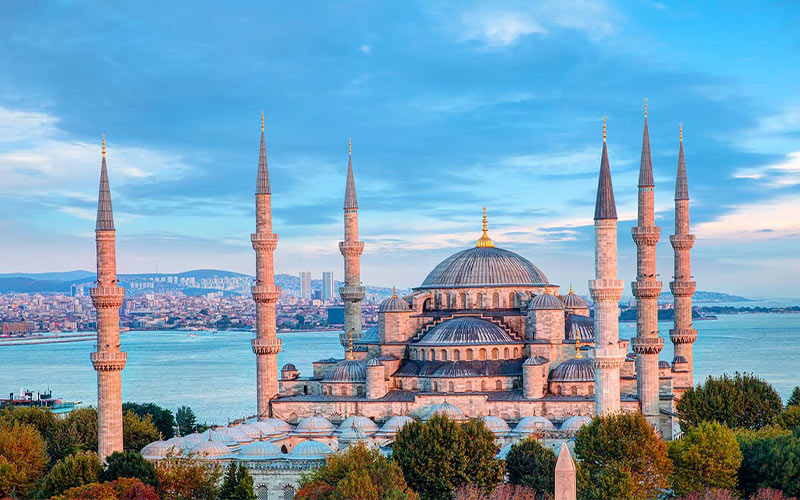
The construction of the Blue Mosque began in 1609 under the reign of Sultan Ahmed I. He commissioned the mosque to be built as a tribute to his legacy and to showcase the power of the Ottoman Empire. The building of the mosque was completed in 1616, and it quickly became a symbol of Islamic art and architecture. The mosque was named after Sultan Ahmed I, who was only 27 years old when he commissioned the construction of the mosque. The Blue Mosque construction was a significant undertaking, and it employed the best architects, engineers, and artisans of the time.
Design and Architecture
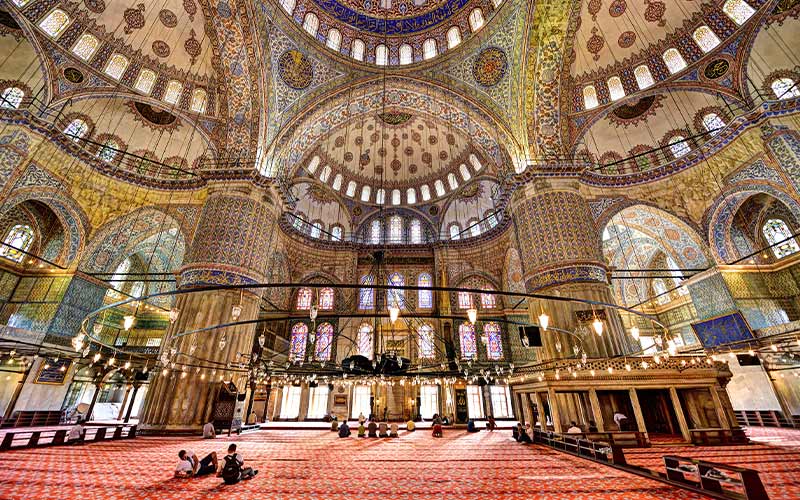
The Blue Mosque is a masterpiece of Ottoman architecture. It features a symmetrical design and a central dome of 23.5 meters in diameter and 43 meters high. The mosque has six minarets, which is unusual as most mosques have only four. This is because Sultan Ahmed I wanted his mosque to be unique and surpass the neighbouring Hagia Sophia in size and grandeur. The mosque has multiple entrances, and a courtyard surrounds it with a fountain in the centre.
One of the most remarkable features of the Istanbul Blue Mosque is its interior design. The walls are covered with beautiful blue tiles, which give the mosque its name. The tiles were handcrafted in the city of Iznik, which was renowned for its ceramic production. The blue tiles were used to create intricate patterns and designs that covered the walls and ceilings of the mosque. The mosque also has stained glass windows that allow natural light to enter and illuminate the interior.
The legends of the Blue Mosque

The Istanbul Blue Mosque (Blue Masjid) is famous for its beautiful blue tiles, intricate calligraphy, and six minarets. As with many historic and beautiful landmarks, many legends and stories are associated with the Blue Mosque's history. Here are a few of the most famous legends:
1. The Legend of the Six Minarets

According to legend, Sultan Ahmed I commissioned the Blue Mosque to be built with six minarets, which was a highly unusual feature at the time. The only other mosque in the world with six minarets was the Great Mosque of Mecca, and it was believed that only the most important mosques could have six minarets. When Sultan's request was granted, the people of Mecca were outraged, believing that their mosque should remain the only one with six minarets. To appease them, Sultan Ahmed I sent a seventh minaret to Mecca, ensuring that the Blue Mosque would remain unique.
2. The Legend of the Muezzin is the person who calls Muslims to prayer from the mosque's minaret

According to legend, the muezzin who was chosen to call the faithful to prayer at the Istanbul Blue Mosque was blind. Despite his blindness, he was known for his beautiful voice and the way he would climb the steep stairs to the minaret with ease. One day, the Sultan visited the mosque during prayer time to hear the muezzin's voice for himself. When he arrived, he was amazed to see the blind muezzin climbing the stairs to the minaret without any difficulty. The Sultan was so moved by the muezzin's faith and devotion that he ordered the construction of a unique staircase to make it easier for him to reach the minaret.
3. The Legend of the Colorful Tiles

According to legend, the tiles were initially supposed to be gold. However, during the mosque's construction, the treasury ran out of funds and insufficient gold to complete the tiles. The Sultan's mother suggested using blue tiles instead, and the result was so stunning that it became the mosque's signature feature.
4. The Legend of the Architect
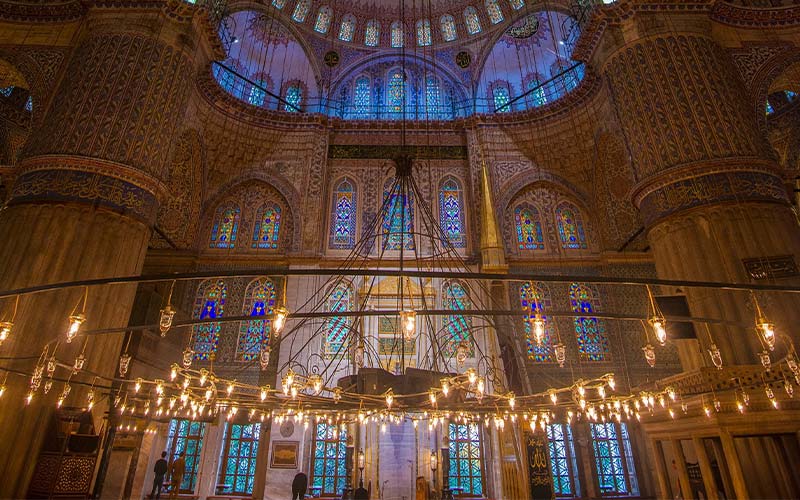
The Istanbul Blue Mosque architect was Sedefkar Mehmed Aga. According to legend, when the Sultan asked Mehmed Aga if he was confident that the mosque would not collapse, the Blue Mosque architect replied that he was confident that it would stand for at least 500 years. However, the Sultan was not satisfied with this answer and ordered that the architect be imprisoned until the mosque was completed. When the mosque was finished, the Sultan was so pleased with the result that he ordered Mehmed Aga's release and gave him a large sum of money as a reward.
These legends add to the Blue Mosque's history and cultural significance. Whether or not they are authentic, they illustrate this magnificent landmark's enduring legacy and its essential role in Islamic art and architecture.
Blue Mosque Location and Neighborhood
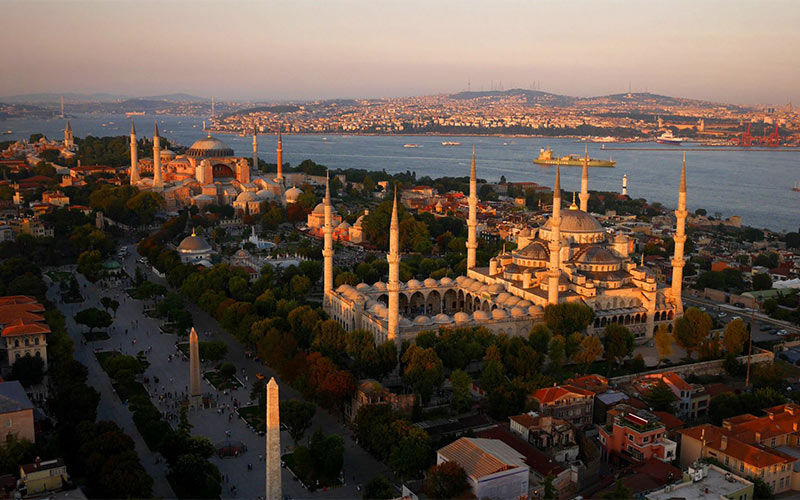
The Blue Mosque(Masjid Sultan Ahmed) is situated on the European side of Istanbul, near the southern tip of the historical peninsula. It is located in Sultanahmet Square, which is a large plaza surrounded by other vital landmarks.
Sultanahmet is one of the oldest and most historic neighbourhoods in Istanbul. It was the heart of the Byzantine and Ottoman empires, and many of their most important buildings are located here. In addition to the Blue Mosque, other notable landmarks in the neighbourhood include the Hagia Sophia, the Topkapi Palace, the Hippodrome, and the Basilica Cistern.
Sultanahmet is also a vibrant and diverse neighbourhood with a rich local culture. Many small shops and markets sell traditional crafts, foods, souvenirs, mosques, churches, and other religious buildings still in use by the local community. Visitors can taste traditional Turkish life by exploring the streets and neighbourhoods around the Blue Mosque.
Blue Mosque Visiting Hours
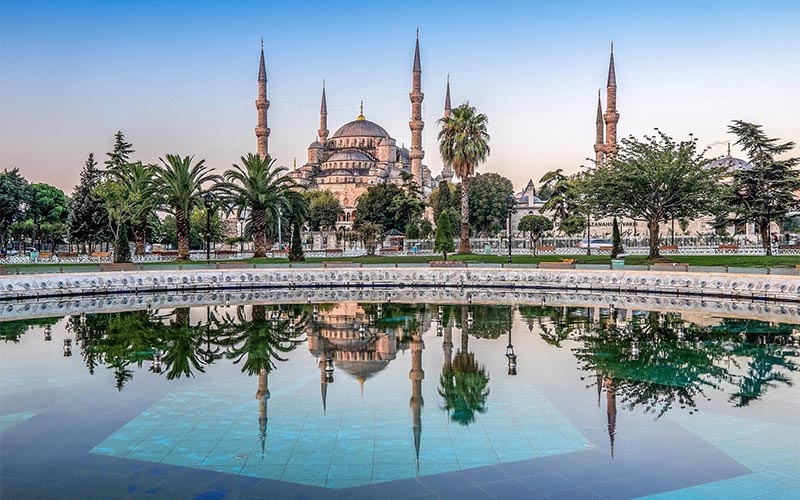
The mosque is open to visitors every day of the week except during prayer times. Visitors are also not allowed to visit during Friday prayers, which is the most important prayer of the week for Muslims.
The mosque is closed to visitors during the five daily prayers, which last about 30 minutes each. You can check the prayer times on the official website or by asking at the entrance.
The mosque is open from 9:00 am to 6:00 pm in winter (October to April).
The mosque is open from 9:00 am to 7:00 pm in the summer (April to October).
The mosque may be closed to visitors during special events or ceremonies.
Blue Mosque Dress Code

Visitors are expected to dress modestly and respectfully when visiting the Blue Mosque. Here are some guidelines for the dress code:
- Both men and women should wear clothing that covers their shoulders and knees.
- Women must wear a headscarf to cover their hair. Some mosques provide headscarves for female visitors at the entrance, but bringing your own is always better.
- Tight or revealing clothing is not allowed.
- Shoes must be removed before entering the mosque.
- It's also recommended to avoid wearing bright or flashy colours and clothing with large logos or slogans.
If visitors do not adhere to the dress code, they may be denied entry to the mosque or asked to cover up with a provided shawl or scarf. It's essential to respect local customs and culture when visiting religious sites like the Blue Mosque. By respecting the customs and traditions of the mosque, you'll have a more enjoyable and respectful visit.
Blue Mosque Entrance Fee
The Blue Mosque is free to enter. There is no entrance fee for visiting the mosque. However, donations are welcome and encouraged to help with the maintenance and upkeep of the mosque. Visitors may also wish to purchase souvenirs or postcards from the gift shop inside the mosque, but this is entirely optional.
Visiting the Blue Mosque
Visitors to the Blue Mosque are welcome to enter and explore the mosque, but as we mentioned before, there are some guidelines to follow. Visitors are also welcome to participate in the guided tours the mosque offers. The tours give visitors a deeper understanding of the history and architecture of the mosque.
How to Get to the Blue Mosque
The Blue Mosque(Sultanahmet Mosque) is easily accessible by various means of transportation. Here are some of the ways you can get to the Blue Mosque:
1. By Public Transport
The easiest way to get to the Blue Mosque by public transport is by using Istanbul's extensive metro and tram systems. If you are coming from the European side of the city, take the T1 tram line and get off at the Sultanahmet stop. If you are coming from the Asian side, take the Marmaray metro line and transfer to the T1 tram line at Sirkeci station. Both the tram and metro run regularly and are an affordable way to get around the city.
2. By Taxi or Private Transfer
Taxis are readily available throughout Istanbul, and a taxi ride to the Blue Mosque from most parts of the city is relatively affordable. However, be aware that traffic in Istanbul can be unpredictable, so it may take longer to get to the mosque during rush hour. Alternatively, you can book a private transfer from your hotel or a travel agency, which is more convenient and convenient.
3. On Foot
If you are staying in the Sultanahmet area, the Blue Mosque is easily accessible on Foot. Walking around the historic district is a great way to explore the city and take in the sights and sounds of Istanbul. The mosque is located close to other famous landmarks, such as the Hagia Sophia and Topkapi Palace, making it a convenient stop on any city walking tour.
Hotels Close to Blue Mosque
There are several hotels located close to the Blue Mosque. Here are some options:
1. Sura Hagia Sophia Hotel Istanbul
2. Hotel Amira Istanbul
3. Empress Zoe Hotel
4. Hotel Hippodrome Istanbul
These are just a few examples of the many hotels that are located close to the Blue Mosque in Istanbul. It's a popular tourist area, so plenty of accommodation options are available to suit all budgets and preferences.
Bottom Line
The Blue Mosque is a stunning example of Ottoman architecture and a symbol of Islamic art and culture. It's a must-visit destination for anyone travelling to Istanbul. The mosque's impressive design and beautiful blue tiles make it a unique and memorable attraction. Visitors to the mosque should follow the guidelines and respect the mosque as a place of worship. The Blue Mosque is a true masterpiece that showcases the skill and craftsmanship of the artisans and architects of the Ottoman Empire.
Ready to explore the Blue Mosque and immerse yourself in Istanbul's rich cultural heritage? Start planning your trip today and experience the beauty and majesty of this iconic landmark!
Comment
Leave a Comment